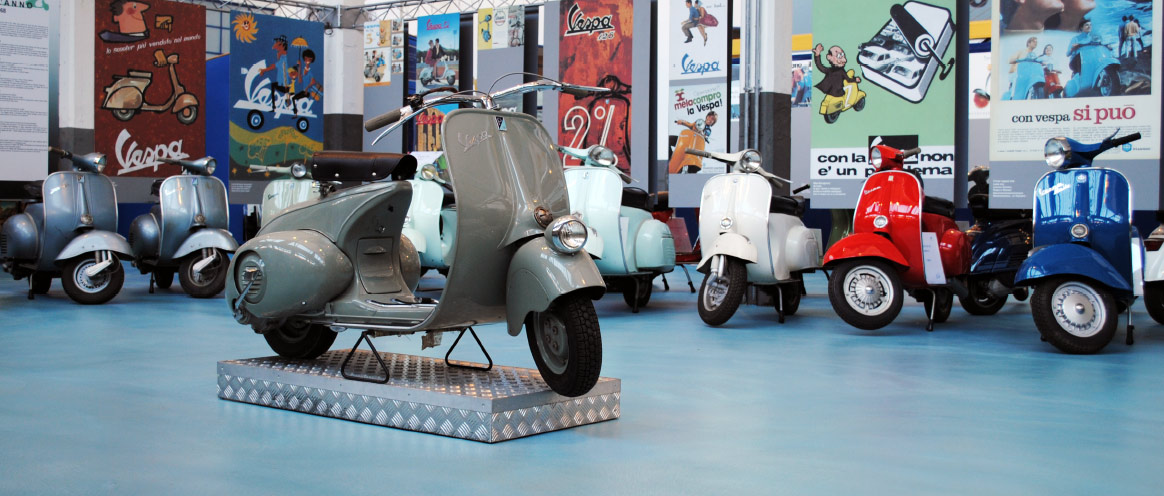
Spring of 1946, seventy-five years ago today as it was then. At the Acquasanta Golf Club in Rome, the Vespa, what would later become one of the greatest phenomena of the world’s motor industry, is unveiled.
A project begun years earlier, with the prototype nicknamed Donald Duck, designed by engineers Renzo Spolti and Vittorio Casini, but which Enrico Piaggio was not entirely convinced of. In its continuing quest for greater practicality, Piaggio decided to revisit the prototype, entrusting it to aeronautical designer Corradino D’Ascanio and designer Mario D’este. Thus was born an original, revolutionary idea, definitely different from the first prototype.
March 29, 1946, was a Friday when the patent for the Vespa 98 was presented, a completely innovative and functional scooter with a unique style, far from the common idea of a motorcycle.
In 2021 the “world’s most famous scooter” celebrates the 75th anniversary of its birth. Without a shadow of a doubt, an unprecedented success that has reached thousands of fans around the world. The Vespa’s debut took place in Rome in the spring of 1946, representing a dream of freedom and a desire to start over after the end of World War II.
A dream that, over the years, would become iconic and represent a way of life to be inspired by. The name “Vespa,” by the way, comes from the spontaneous exclamation “it looks like a Vespa!” uttered by Enrico Piaggio himself when he first saw the wide central shape and narrow waist of the Mp6 prototype produced at Piaggio’s Pontedera plant in Tuscany.
The Vespa was born in an important historical period for Italy, the postwar period. Years when the country wants to wake up and start living again, leaving behind the horrors of war. Italy is growing and new needs arise. Among them, mobility is definitely a priority, and although the economy is improving, not everyone can afford to buy a car.
Here then is the genius idea: the new Vespa, a light, comfortable, fast and innovative scooter, The absolute novelty is the dynamic with which it is presented to the public: payment in installments and advertising centered on the means of transportation not only for professionals, but for everyone.
So that since its inception, the Vespa has involved everyone, especially women. Because it is an easy means of transportation even in a skirt. An aspect that also reverberates in advertising, so much so that Vespa advertising campaigns quickly become as iconic as the vehicle. The message is simple and direct: “The Vespa is not a motorcycle, but a small two-wheeled car.”
The 1950s saw a profound change in the use of the Vespa from being primarily used to commute to work to becoming a vehicle for leisure and entertainment in an Italy that was flourishing again after the hardships of earlier years.
“Vespizzatevi!” then became the slogan by which in those years, the advantages one could have as an owner of a Vespa were emphasized.
In those years, moreover, the Vespa became for everyone the synonym and symbol of Italian design and ingenuity in the world. A true media phenomenon, which also became the subject of several film scripts such as in the film, later to become a “cult,” “Roman Holiday” in 1953.
The Vespa becomes a protagonist in films, but also in literature and, of course, in advertising. It is the faithful traveling companion of Italy’s history. The success is now international.
By the 1980s, the myth of the Vespa had crossed national borders so much so that Piaggio pushed hard on the accelerator (pun intended) with the spread of the Vespa, creating a large service network throughout Europe and the rest of the world. During these same years, the legendary two-wheeled vehicle received worldwide recognition, consolidating its image in all foreign markets.
For these reasons, Piaggio once again decides to focus heavily on advertising, involving young people in its message that riding their Vespa can make any dream come true. Goal achieved: the Vespa is increasingly becoming the scooter of young people to get around the city, the country, everywhere.
The climb to the Olympus of the unforgettable continues, and Vespa begins to count the various attempts at imitation. Which remain as such because the Vespa cannot be imitated!
In the new millennium, the Vespa evolves. New models are born that definitely conquer foreign markets. The Vespa becomes a “single-speed” scooter, a choice that divides enthusiasts. Those who see a kind of sacrilege done to a myth those who, on the other hand, understand the choices and see in these models the natural evolution of that Vespa presented in Rome on March 29, 1946.

Meanwhile, the new electric Vespa, Piaggio’s latest arrival, wins several awards including the Compasso d’Oro ADI (Industrial Design Association), which, in presenting this award, emphasizes the values, attention and respect for the environment demonstrated by Piaggio in the creation of this new model.
The truth is that the Vespa continues to fascinate, maintaining thatunmistakable design that has always distinguished it. Just as Enrico Piaggio exclaimed back in the day, “But it looks like a Vespa.”
This article was contributed by Jenn Correa of the Vespa Tour Staff.
PHOTO CREDITS:
Piaggio & C.
Discover the Chianti Region by Vespa: A Unique Tuscan Experience
What to Do in Spring: Discover Italy on a Vespa Tour
Experience the Langhe: 4 Exclusive Apartments in Alba
Mother’s Day: the perfect gift idea
Discovering Lake Maggiore and Lake Orta: the Vespa experience
Valentine’s Day on a Vespa: The Best Gift Ideas for Couples
Vespa Tours
The Italian Experience snc of Luca Paolo Celotto and Diego Remondino
P.IVA 12327230012 – REA: CN – 322676
Tua Assicurazioni liability policy N°40324512001433
Fund Policy N°40324512000456 dated 05/04/2024
Scia Prot.no. 0000752 dated 24/02/2021 issued by the Province of Cuneo
Notifications